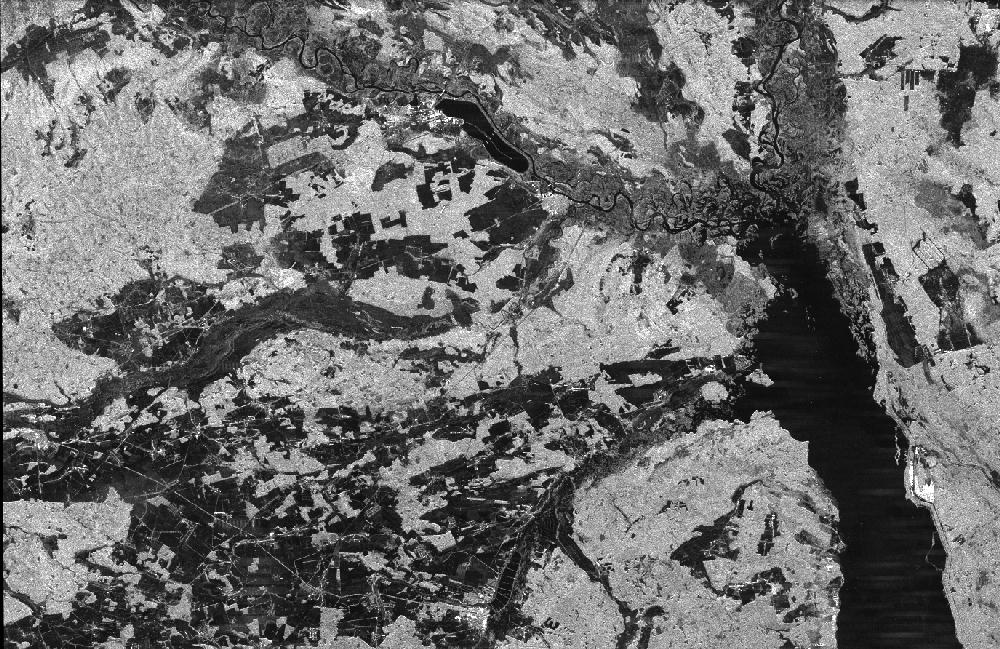Chernobyl, Ukraine
 This is an image of the Chernobyl nuclear power plant and its surroundings,
centered at 51.17 north latitude and 30.15 west longitude. The image was
acquired by the Spaceborne Imaging Radar-C and X-band Synthetic Aperture
Radar aboard the space shuttle Endeavour on its 16th orbit on October 1,
1994. The area is located on the northern border of the Ukraine Republic
and was produced by using the L-band (horizontally transmitted and received)
polarization. The differences in the intensity are due to differences in
vegetation cover, with brighter areas being indicative of more vegetation.
These data were acquired as part of a collaboration between NASA and the
National Space Agency of Ukraine in Remote Sensing and Earth Sciences.
NASA has included several sites provided by the Ukrainian space agency
as targets of opportunity during the second flight of SIR-C/X-SAR. The
Ukrainian space agency also plans to conduct airborne surveys of these
sites during the mission. The Chernobyl nuclear power plant is located
toward the top of the image near the Pripyat River. The 12-kilometer (7.44-mile)-long
cooling pond is easily distinguishable as an elongated dark shape in the
center near the top of the image. The reactor complex is visible as the
bright area to the extreme left of the cooling pond and the city of Chernobyl
is the bright area just below the cooling pond next to the Pripyat River.
The large dark area in the bottom right of the image is the Kiev Reservoir
just north of Kiev. Also visible is the Dnieper River, which feeds into
the Kiev Reservoir from the top of the image. The Soviet government evacuated
116,000 people within 30 kilometers (18.6 miles) of the Chernobyl reactor
after the explosion and fire on April 26, 1986.
This is an image of the Chernobyl nuclear power plant and its surroundings,
centered at 51.17 north latitude and 30.15 west longitude. The image was
acquired by the Spaceborne Imaging Radar-C and X-band Synthetic Aperture
Radar aboard the space shuttle Endeavour on its 16th orbit on October 1,
1994. The area is located on the northern border of the Ukraine Republic
and was produced by using the L-band (horizontally transmitted and received)
polarization. The differences in the intensity are due to differences in
vegetation cover, with brighter areas being indicative of more vegetation.
These data were acquired as part of a collaboration between NASA and the
National Space Agency of Ukraine in Remote Sensing and Earth Sciences.
NASA has included several sites provided by the Ukrainian space agency
as targets of opportunity during the second flight of SIR-C/X-SAR. The
Ukrainian space agency also plans to conduct airborne surveys of these
sites during the mission. The Chernobyl nuclear power plant is located
toward the top of the image near the Pripyat River. The 12-kilometer (7.44-mile)-long
cooling pond is easily distinguishable as an elongated dark shape in the
center near the top of the image. The reactor complex is visible as the
bright area to the extreme left of the cooling pond and the city of Chernobyl
is the bright area just below the cooling pond next to the Pripyat River.
The large dark area in the bottom right of the image is the Kiev Reservoir
just north of Kiev. Also visible is the Dnieper River, which feeds into
the Kiev Reservoir from the top of the image. The Soviet government evacuated
116,000 people within 30 kilometers (18.6 miles) of the Chernobyl reactor
after the explosion and fire on April 26, 1986.
For a full-resolution (1.3-megabyte) copy of this image, press here
Spaceborne Imaging Radar-C and X-band Synthetic Aperture Radar (SIR-C/X-SAR)
is part of NASA's Mission to Planet Earth. The radars illuminate Earth
with microwaves, allowing detailed observations at any time, regardless
of weather or sunlight conditions. SIR-C/X-SAR uses three microwave wavelengths:
L- band (24 cm), C-band (6 cm) and X-band (3 cm). The multi- frequency
data will be used by the international scientific community to better understand
the global environment and how it is changing. The SIR-C/X-SAR data, complemented
by aircraft and ground studies, will give scientists clearer insights into
those environmental changes which are caused by nature and those changes
which are induced by human activity. SIR-C w as developed by NASA's Jet
Propulsion Laboratory. X-SAR was developed by the Dornier and Alenia Spazio
companies for the German space agency, Deutsche Agentur fuer Raumfahrtangelegenheiten
(DARA), and the Italian space agency, Agenzia Spaziale Italiana (ASI),
with the Deutsche Forschungsanstalt fuer Luft und Raumfahrt e.v.(DLR),
the major partner in science, operations and data processing of X-SAR.


